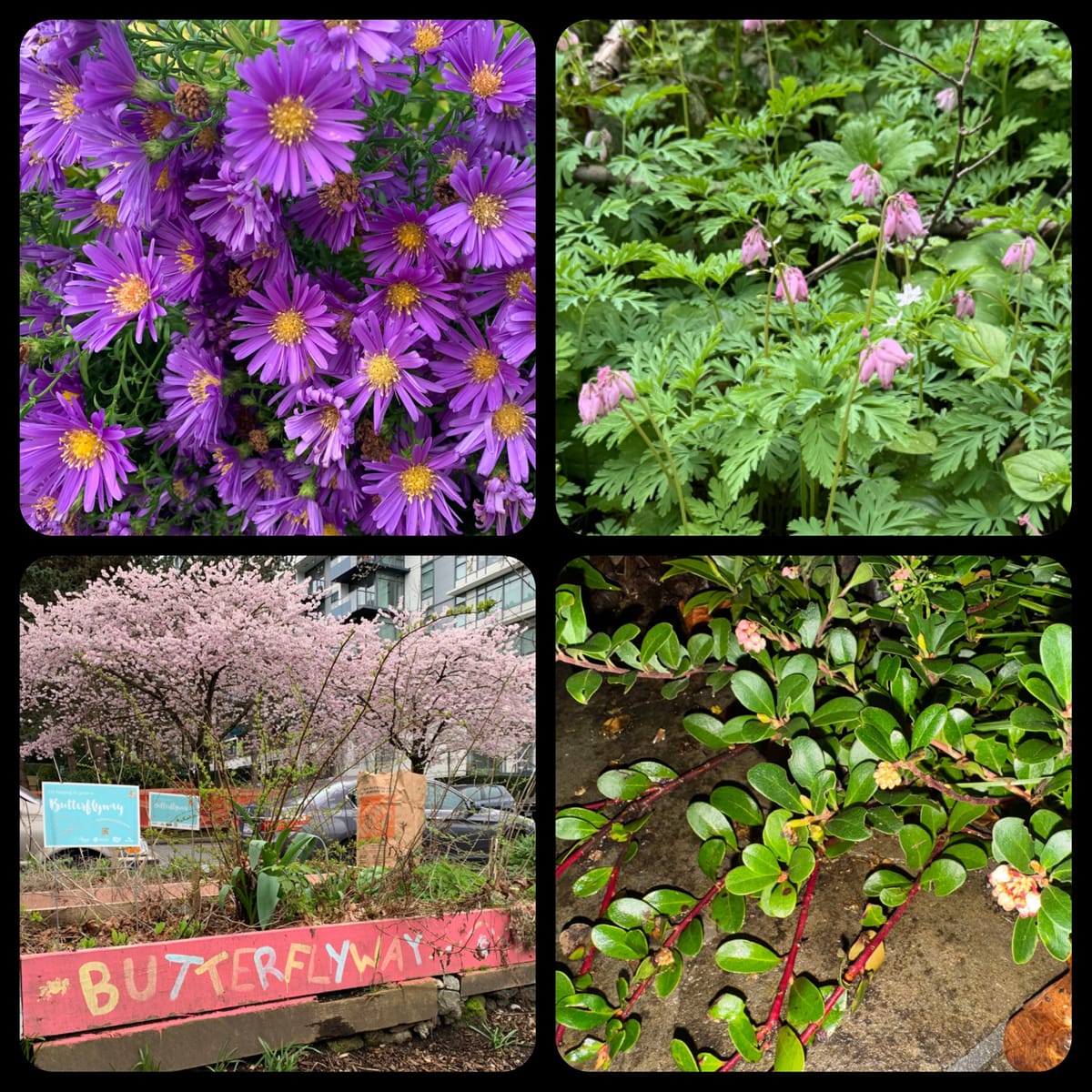
✍️ By Karalee Greer | WBN News – Kitsilano | April 28, 2025
I'm an avid gardener. I'm also a Butterflyway Ranger with the David Suzuki Foundation https://davidsuzuki.org/take-action/act-locally/butterflyway/ and planting native plants is encouraged to better support our butterflies and bees. I have all of the listed native plants in my garden except the Nootka Rose and the Oregon Grape. I've met many neighbours and other community gardeners through my gardening ventures in Kitsilano.
Kitsilano, a vibrant neighborhood in Vancouver, is home to a diverse array of native plants that not only enhance the local landscape but also play a crucial role in supporting pollinators like bees and butterflies. These indigenous species are well-adapted to the region's climate and soil conditions, making them resilient choices for gardeners and conservationists alike.
🌿 Native Plants of Kitsilano – Full Descriptions
🌸 Red-Flowering Currant (Ribes sanguineum)
A stunning deciduous shrub, Red-flowering currant produces brilliant clusters of pink to deep red flowers in early to mid-spring (March–April). It is a perennial and thrives in full sun to partial shade. Once established, it is moderately drought-tolerant, making it an excellent low-maintenance choice for local gardens. Its early blooms provide crucial nectar for bees and hummingbirds emerging after winter.
🌿 Salal (Gaultheria shallon)
An iconic evergreen shrub of the Pacific Northwest, Salal features leathery, dark green leaves year-round and white to pinkish bell-shaped flowers that bloom in late spring (May–June). It grows best in partial to full shade and is highly drought-tolerant once established. Salal berries are edible and loved by wildlife, while the thick foliage provides excellent cover for pollinators and birds.
🌼 Douglas Aster (Symphyotrichum subspicatum)
Douglas Aster is a hardy perennial that bursts into lavender-blue daisy-like blooms in late summer (July–September), offering vital nectar during a dry season. It prefers full sun to light shade and is moderately drought-resistant after establishment. Its long flowering season makes it an essential plant for sustaining pollinators into fall.
🌹 Nootka Rose (Rosa nutkana)
This native deciduous shrub produces fragrant, single-petaled pink roses in late spring to early summer (May–June). It grows well in full sun to partial shade and is moderately drought-tolerant. Its dense, thorny thickets provide shelter for wildlife, while its flowers are a magnet for bees and butterflies.
🍇 Oregon Grape (Mahonia aquifolium)
Oregon Grape is a tough, glossy-leaved evergreen shrub with sprays of small yellow flowers blooming in early spring (March–April), followed by dark blue berries. It thrives in partial shade to full sun and is highly drought-tolerant once mature. Oregon Grape adds year-round interest and is a critical early nectar source for bees.
🌿 Kinnikinnick (Arctostaphylos uva-ursi)
Also known as Bearberry, Kinnikinnick is a low-growing, mat-forming evergreen groundcover with tiny pink bell-shaped flowers in spring (April–May) and bright red berries in fall. It grows best in full sun to partial shade and is extremely drought-tolerant — ideal for dry, sandy soils. Kinnikinnick stabilizes soil and supports bees and small mammals.
💗 Western Bleeding Heart (Dicentra formosa)
This delicate, shade-loving perennial is known for its fern-like foliage and graceful pink, heart-shaped flowers that bloom in spring (April–June). It thrives in full to partial shade and prefers moist soil but has moderate drought tolerance once well-established. It's an early-season favorite for pollinators emerging from winter dormancy.
Garden Centers
Local garden centers such as Figaro's Garden and Hunter's Garden Centre in Vancouver, as well as Dykhof Nurseries in North Vancouver, stock a variety of these native plants, making it convenient for residents to incorporate them into their gardens. iscmv.ca
Planting native species is more than a landscaping choice; it's a commitment to ecological stewardship. Incorporating these plants into your garden not only enhances its beauty but also plays a vital role in supporting local wildlife. These plants have co-evolved with local pollinators, providing essential nectar and pollen sources. By choosing native plants, gardeners support the life cycles of bees, butterflies, and other beneficial insects, contributing to biodiversity and the health of the ecosystem. Vancouver Bee Project
Tags: #WBN News -Kitsilano #Karalee Greer #Kitsilano #Native Plants #Pollinator Friendly #Eco Friendly Gardening #David Suzuki Foundation

